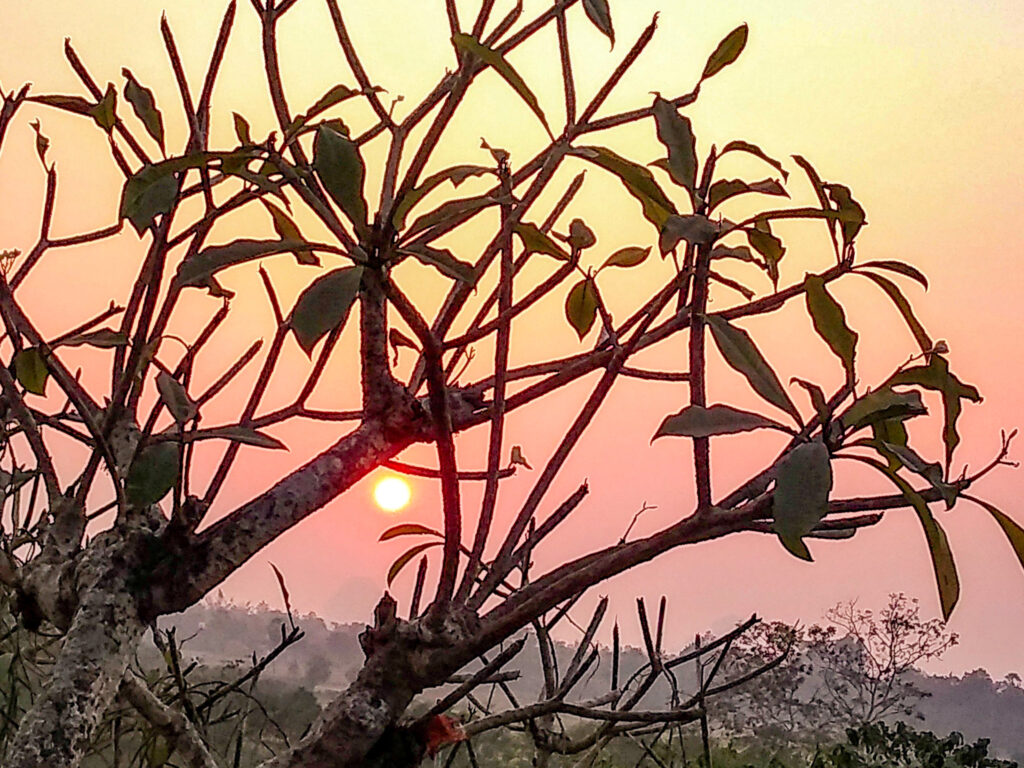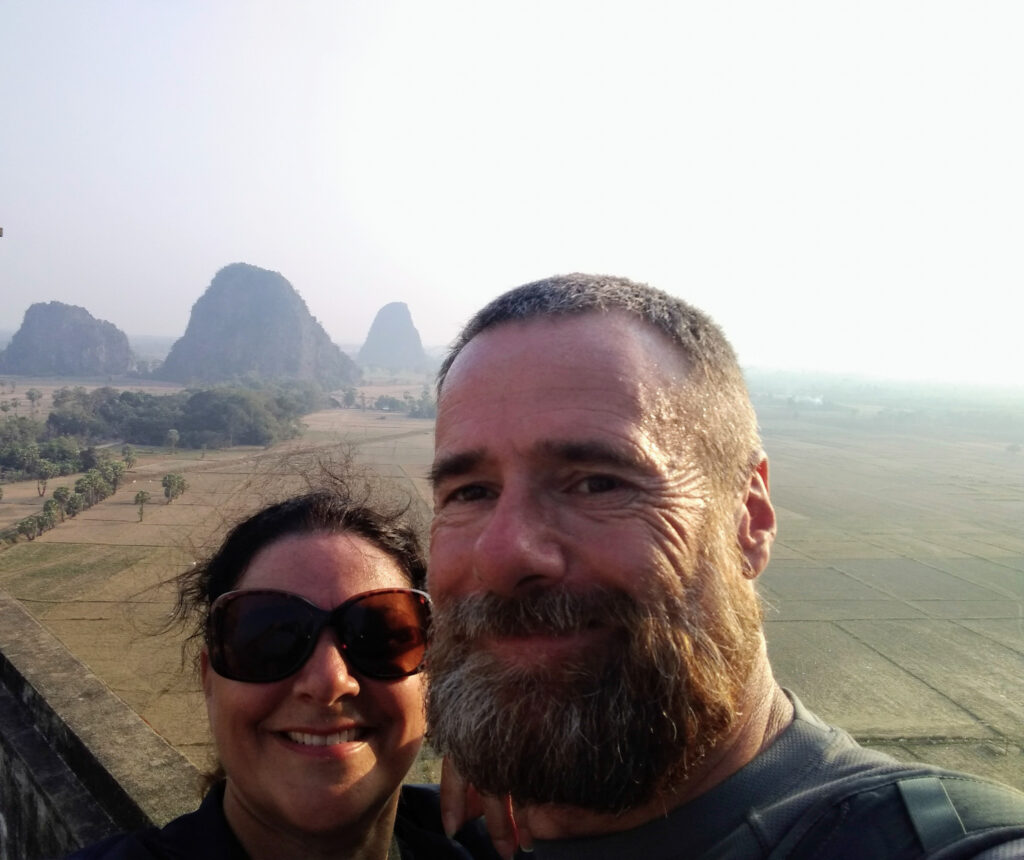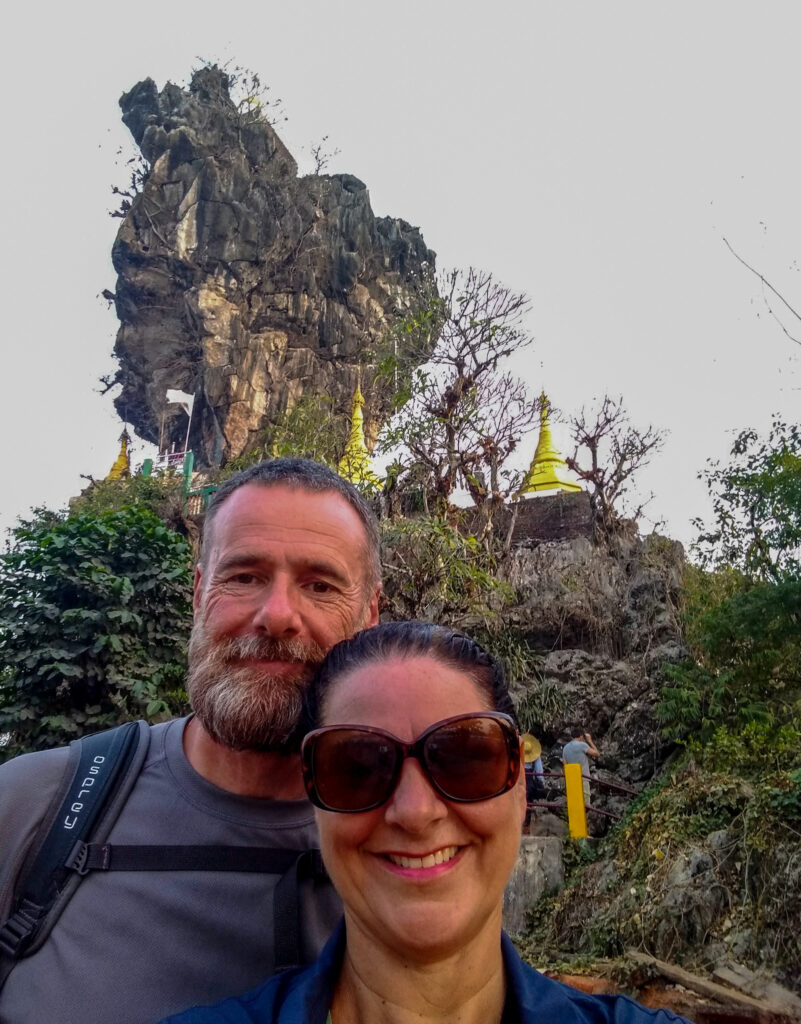“The magical region in the south of Myanmar”

See photos
Where is Hpa An?
Hpa An pronounced Pah An. The capital of Kayin State on the eastern bank of the Thanlwin river. English is understood but spoken far less in this area of Myanmar. However, restaurant and cafe menus all seem to be in English as well as Burmese.
The town is encircled by the dramatic Karst mountains, which jut out from the surrounding plains. Many of the mountains contain large and religiously significant caves, all of which make Hpa An an amazing place to visit.

Getting there
Our journey from Inle Lake to Hpa An was on the overnight bus.
Our accommodation
During our time in Hpa An, we chose to stay at the Hotel Glory, which we booked through Booking.com. Having checked in and gone to our room, we soon realised that the room and hotel weren’t for us. So a short discussion with the reception and a message to Booking.com we left in search of alternative accommodation.
On the walk to the Hotel Glory, we passed the Vintage Hpa An Hotel. Retracing our steps back, we went in to see if it was an acceptable place to stay. Not only was it acceptable, but they also had availability.
Our room was spacious and clean, has a flat-screen satellite TV, a fridge, and a seating area. The ensuite bathroom had a shower and free toiletries. The rooftop restaurant did some good local food and provided a good breakfast buffet.
Places of interest
For our day of sightseeing, we chose to hire a scooter from our hotel at 10000 Kyat for the entire day. Fuel was available at roadside vendors, slightly more expensive than petrol stations at 1000 Kyat a litre, but far more convenient.

Sadan Cave
Our first sightseeing stop was the stunning Sadan Cave. About an hour’s ride from Hpa An. Leaving the town we took Highway 85, the Myawaddy Hpa An road.
There is a toll booth on the way but, scooters aren’t required to pay. Just drive through the centre VIP lane. Shortly after, is the town of Ein Du. Take the right-hand fork there and then the next right. There is a small signpost for Sadan cave.
This road took us through some lovely small traditional villages. Children waved and gave us real genuine smiles shouting hello as we rode through.
At the end of that road, turn right and Sadan cave was at the end of the road. The whole ride there took us through some beautiful scenery.
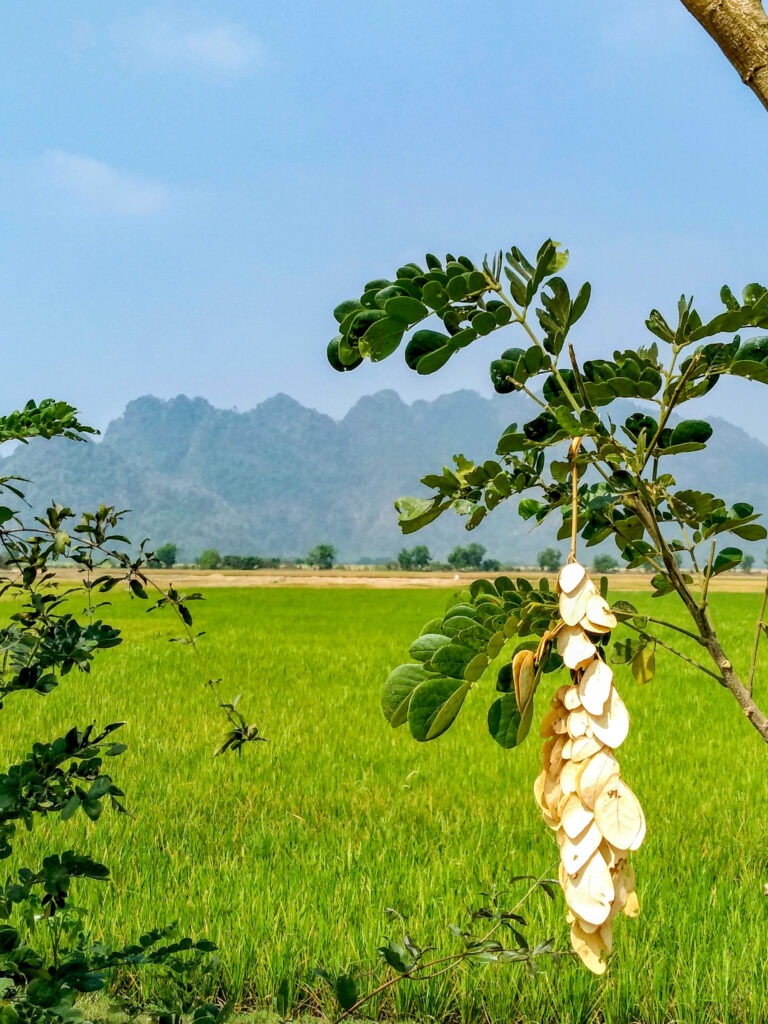

Passing traditional bamboo houses on stilts. Women out walking with colourful umbrellas as sunshades, thanaka applied to their faces and children out collecting the roadside rubbish.

Parking the scooter at the cave cost 500 Kyat and entry to the cave was 1000 Kyat per person. On entering the cave it opens up into a gigantic cavern, filled with Buddhas and pagodas.

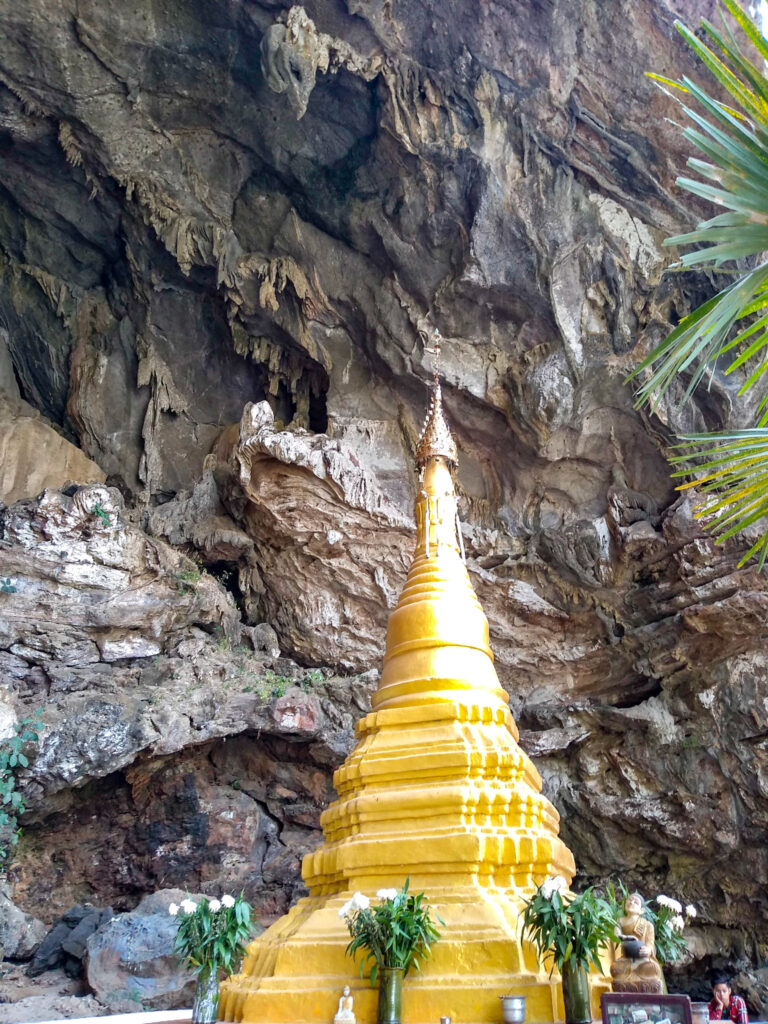


The cave system extends right under the mountain. Passing through chambers with impressive rock formations and bringing us out on the other side of the mountain at a small lake.

It is truly impressive. Make sure that you carry your shoes with you as you go through the cave. Exiting on the other side of the mountain there are small wooden shared canoes on the lake. They take you back under the mountain for 1000 Kyat per person.


Dropping off about a 10-minute scenic walk from the main entrance.



Kaw Ka Taung cave and pool
Leaving Sadan, we made our way back towards Hpa An, to our next destination of Kaw Ka Taung cave and pool. A short distance off Highway 85.

There are many Buddha statues in the cave which is quite small at only 53 meters long. It has a fully tiled floor and it is full of magnificent statues.
A short distance from the cave, align a row of stone monks. Further on is a natural pool giving you the opportunity to cool off after seeing the cave. Should you feel brave enough to get in the murky water.


It also offers lovely views of the surrounding rice paddies and mountains. There are also a number of restaurants here that serve great local and Thai food. It is possible to go kayaking in surrounding paddy fields when they’re flooded.
Yathae Pyan cave
After having some lunch in one of the restaurants, it was time to move on again, this time crossing over the Thanlwin river to get to the other 3 caves in the area, Yathae Pyan, Kawgun and Bat caves.
Unfortunately, this means going all the way back into town and then coming back out, staying on Highway 85. Once across the Thanlwin bridge, stay on the main road until the toll booths.
Again scooters aren’t required to pay, so go straight through the side lane. Immediately after the booths, turn left and almost double back on yourself.
Keep following the road until the signpost for the caves. Bat cave is straight on, for the other 2, turn right. We turned right and went to Yathae Pyan cave first.



This was, in our opinion, the best cave overall. Walking through the cave seeing the huge chambers, each with Buddha statues and pagodas. Huge stalagmites and stalactites. Bats and even monkeys.
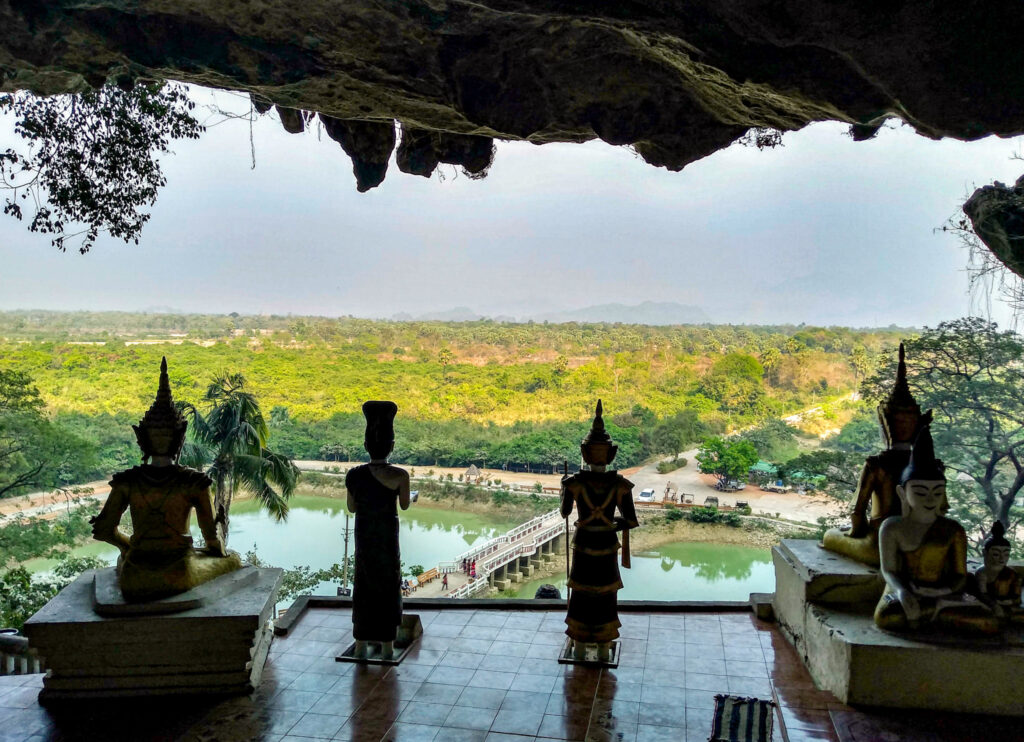


Passing right through the mountain we saw daylight in the distance. Climbing up some steep steps that had been cut into the mountain for visitor’s convenience. We emerged to find absolutely stunning scenic views out across the plains and paddy fields.
Making our way across a wooden walkway that leads to a couple of platforms where the views could really be admired.



On the very top the last platform sits an impressive statue.

It was also possible to take a canoe trip to Natural Water Cave, from adjacent to the entrance. We opted not to as we still had quite a bit more to see and daylight was running out. Scooter parking at the cave was 500 Kyat but entry to the cave was free.
Kaw Gon Cave
Next on our list was Kaw Gon cave. This cave was different and offered beautiful 7th-century artwork. Consisting of thousands of tiny clay buddhas, carvings and paintings, sited all over the walls and roof of this open cavern.

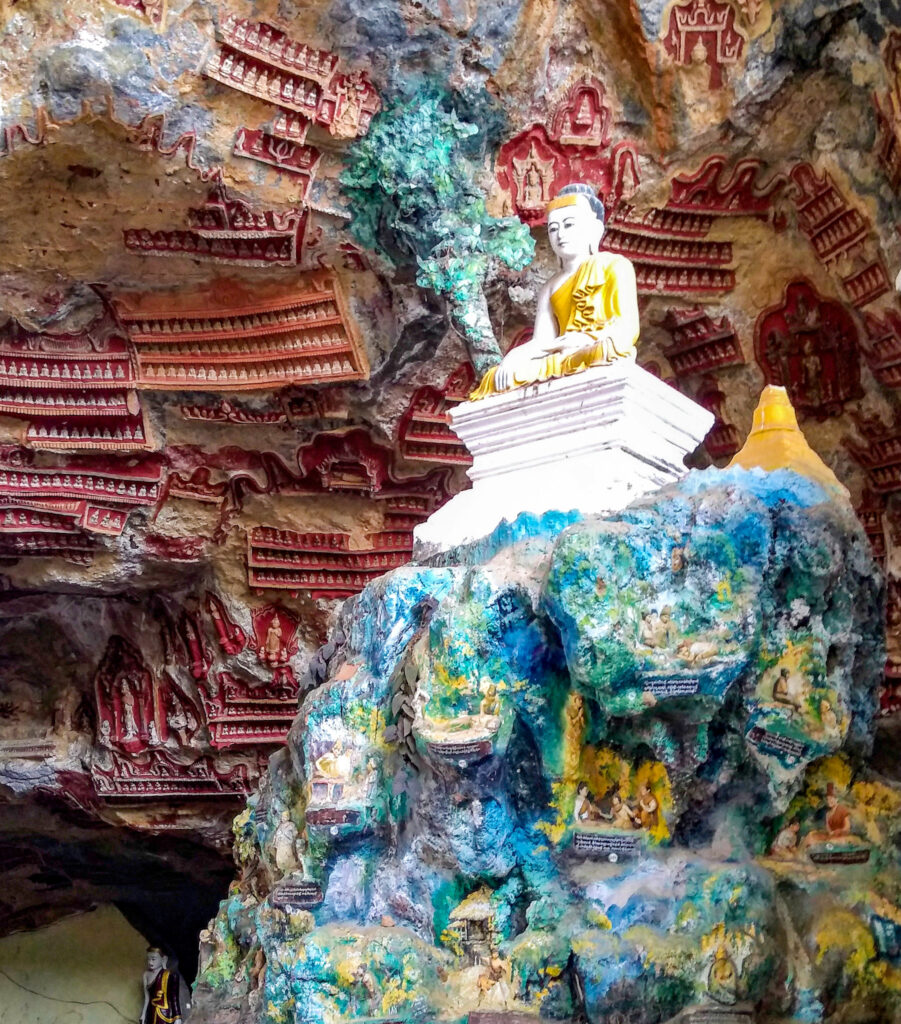
Also, there is a pagoda sited high on the mountain. Access to which is by a very steep set of steps. Worth the effort for the vista from the top. Entrance to this cave was 3000 Kyat per person.



Kyauk Ka Lat Pagoda
From Kaw Gon cave we planned on going onto Bat cave. It was getting late and we really wanted to visit Kyauk Ka Lat Pagoda before it got dark. So we headed back across the Thanlwin bridge towards Mawlamyine. Following the signs for the Kyauk Ka Lat Pagoda.
Located in a Buddhist temple complex. Kyauk Ka Lat Pagoda is built on a prominent limestone rock, only accessible by stairs carved in the rock.



Surrounded by an artificial lake with white egrets, the whole complex is bordered by paddy fields. With Mount Zwegabin as a backdrop, it’s truly magnificent sight.

The island is reached via a wooden footbridge. Access is only permitted as high as the shrine halfway up the outcrop. The complex is an active monastery and meditation site, housing a community of monks.



